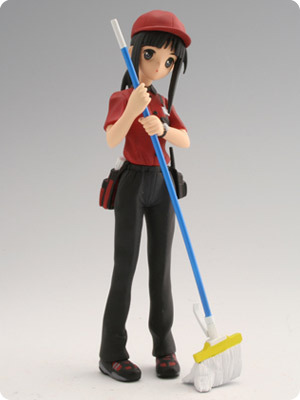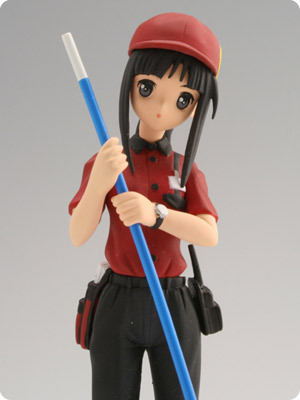#hiraizumi
Text

Kawase Hasui (1883-1957)—Konjiki Hall of Chusonji Temple, Hiraizumi [woodblock print, 1935]
892 notes
·
View notes
Text
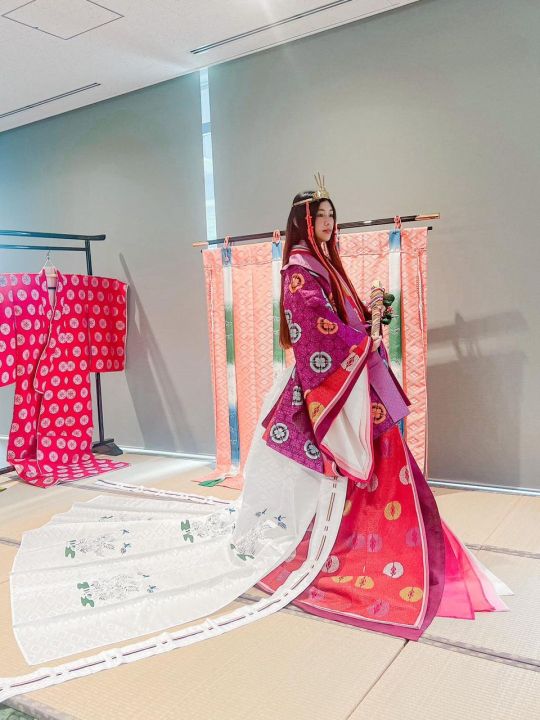

Dress as Heian Princess at Hiraizumi, by Cheeserland
I love how elaborate the pattern is and beautiful the design is.
9 notes
·
View notes
Video
Traditional deer dance by Takashi Muramatsu
Via Flickr:
Traditional deer dance was performed at Moutsuuji Temple, Hiraizumi, Japan
2 notes
·
View notes
Photo

中尊寺金色堂 🌲 Chūson-ji Temple’s Golden Hall 🗾 #中尊寺 #金色堂 #平泉 #世界遺産 #chusonji #goldenhall #hiraizumi #worldheritage 🇯🇵 (中尊寺金色堂) https://www.instagram.com/p/CqJrX0qBmFcbnA3_FlU77op9qpMjGn8Yw8L_Vc0/?igshid=NGJjMDIxMWI=
0 notes
Text
Hiraizumi
Située dans la partie sud-ouest de la préfecture d'Iwate, Hiraizumi compte plus de 3 000 trésors nationaux et sites historiques entourés de jardins idylliques.
#japon #voyage #tourisme
#culture #evasion #tohoku #iwate #ichinoseki #bouddha #motsuji
Située dans la partie sud-ouest de la préfecture d'Iwate, Hiraizumi compte plus de 3 000 trésors nationaux et sites historiques entourés de jardins idylliques. La région de Tohoku dans le nord-est du Japon a prospéré au 11ème siècle sous le règne du clan Fujiwara, et Hiraizumi était le centre de cette prospérité.
Chuson Ji
Le temple Chūson-ji a été fondé en 850 par Ennin (Jikaku Daishi), un…
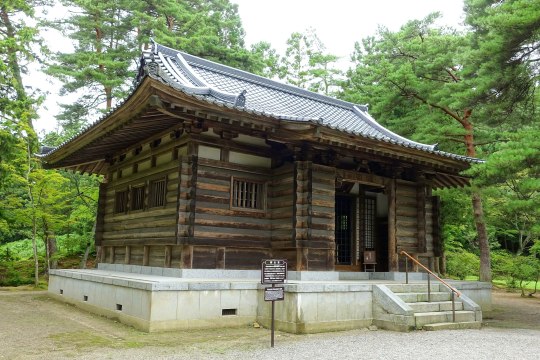
View On WordPress
0 notes
Photo
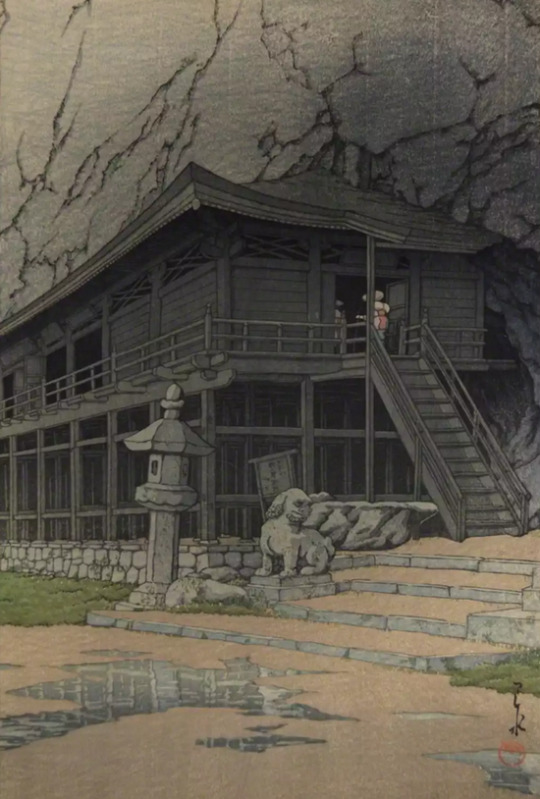
6 notes
·
View notes
Photo

Bishamon Hall at Tagaya, Hiraizumi (1936) by Kawase Hasui (Japanese, 1883–1957).
Watercolour, ink and colour on paper.
Image and text information courtesy MFA Boston.
42 notes
·
View notes
Text

Woah she’s gorgeous
3 notes
·
View notes
Text
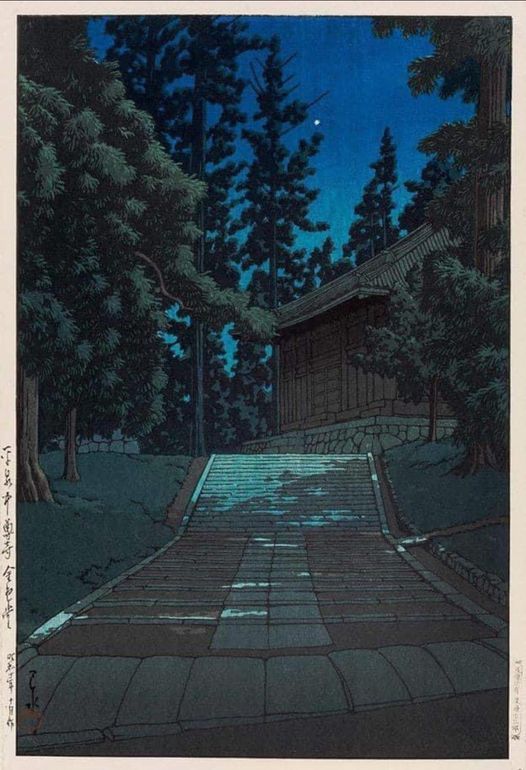
The Golden Hall at Chûson-ji Temple in Hiraizumi, Hasui Kawase, 1935
#art#art history#Asian art#Japan#Japanese art#East Asia#East Asian art#shin-hanga#woodblock print#Hasui Kawase#Kawase Hasui#night scene#landscape#landscape art#Showa period#Showa era#20th century art
974 notes
·
View notes
Text
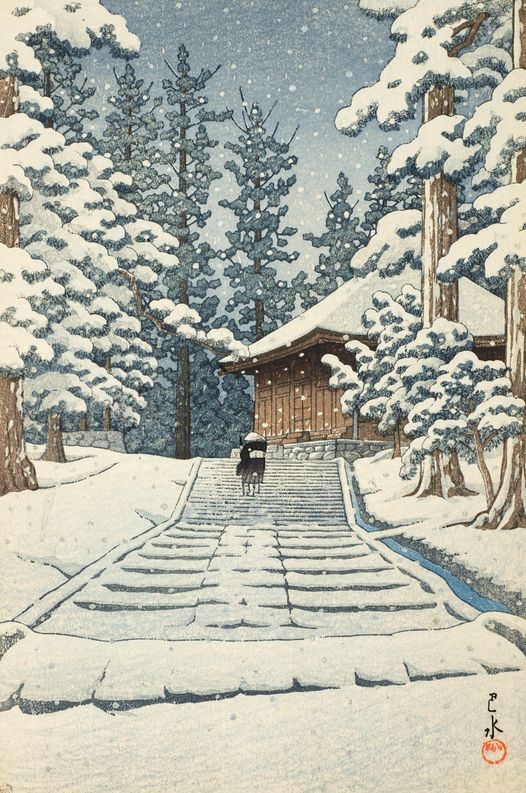
Kawase Hasui - "Konjiki Hall at Hiraizumi"
woodblock print, 1957
107 notes
·
View notes
Photo
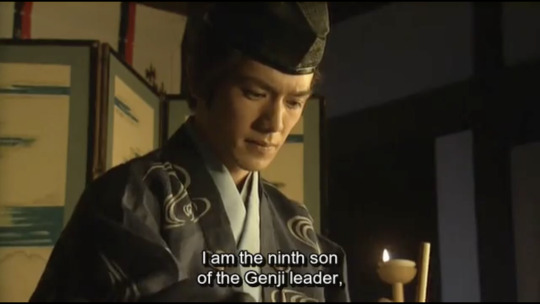
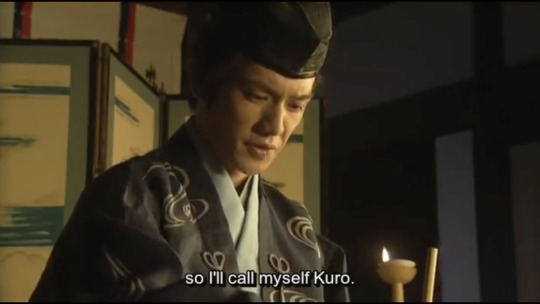
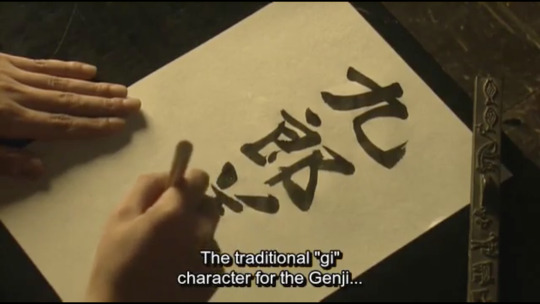
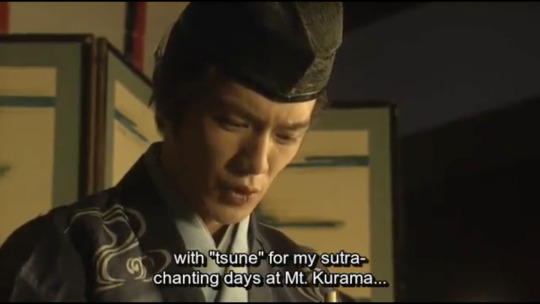
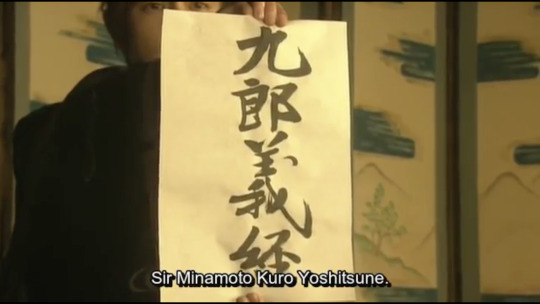
Yoshitsune (Ep 9)
Ushiwakamaru goes through a “Rite of Passage” upon leaving Kyoto, and changes his name to “Minamoto Kuro Yoshitsune”.
In Japanese culture, the Rite of Passage ritually marks a person’s transition from one status (from one role, phase of life, or social status to another).
Yoshitsune finally leaves behind his life in Kyoto to journey to Hiraizumi, which is described as Pure Land on Earth, based on Pure Land Buddhism.
#yoshitsune#minamoto no yoshitsune#hideaki takizawa#takizawa hideaki#taiga drama#japanese historical drama#japanese drama#j drama#jdrama#dorama#japan#samurai#rite of passage#monk#hiraizumi#pure land buddhism#genpei war#japanese history#japanese culture
13 notes
·
View notes
Text
Mai, Satono and their peers: a look into the world of dōji

Okay, look, I get it, Mai and Satono are not the most thrilling characters. I suspect they would be at the very bottom of the list of stage 5 bosses people would like to see expanded upon. Perhaps they are not the optimal pick for another research deep dive. However, I would nonetheless like to try to convince you they should not be ignored altogether. If you are not convinced, this article has it all: esoteric Buddhism, accusations of heresy, liver eating, and even alleged innuendos.
As a bonus, I will also discuss a few other famous Buddhist attendant deities more or less directly tied to Touhou. Among other things, you will learn which figure technically tied to the plot of UFO is missing from its cast and what a controversial claim about a certain deity being a teenage form of Amaterasu has to do with Akyuu.
Mai, Satono and the grand Matarajin callout of 1698

An Edo period depiction of Matarajin and his attendants (via Bernard Faure's Protectors and Predators; reproduced here for educational purposes only)
As indicated both by their family names and their designs, Mai and Satono are based on Nishita Dōji (爾子多童子) and Chōreita Dōji (丁令多童子), respectively. These two deities are commonly depicted alongside Matarajin, acting as his attendants, or dōji. Nishita is depicted holding bamboo leaves and dancing, while Chōreita - playing a drum and holding ginger leaves. ZUN kept the plant attributes, though he clearly passed on the drum. In the HSiFS interview in SCoOW he said he initially wanted both of them to hold both types of leaves at once, so I presume that’s when the decision to skip the instrument has originally been made.
We do not actually fully know how Nishita and Chōreita initially developed. It is possible that their emergence was a part of a broader process of overhauling Matarajin’s iconography. While initially imagined as a fearsome multi-armed and multi-headed wrathful deity, with time he took the form of an old man dressed like a noble and came to be associated with fate and performing arts. The conventional depictions, with the attendants dancing while Matarajin plays a drum under the Big Dipper, neatly convey both of these roles. The group was additionally responsible for revealing the three paths (defilements, karma, and suffering) and three poisons (greed, hatred, and desire) to devotees.
In addition to being a mainstay of Matarajin’s iconography, Ninshita and Chōreita also had a role to play in a special ceremony focused on their master, genshi kimyōdan (玄旨帰命壇). This term is derived from the names of two separate Tendai initiation rituals, genshidan (玄旨壇) and kimyōdan (帰命壇).
Genshi kimyōdan can actually be considered the reason why Matarajin is relatively obscure today. In 1698, the rites were outlawed during a campaign meant to reform the Tendai school. It was lead by the monk Reiku (霊空), who compiled his opinions about various rituals in Hekijahen (闢邪篇, loosely “Repudiation of Heresies”). Matarajin is not directly mentioned there, and the polemic with genshi kimyōdan is instead focused on a set of thirteen kōan pertaining to it, with mistakes pointed out for each of them. Evidently this was pretty successful at curbing his prominence anyway, though.
By the 1720s, even members of Tendai clergy could be somewhat puzzled after stumbling upon references to Matarajin, and in a text from 1782 we can read that he was a “false icon created by the stupidest of stupid folks“. He ceased to be venerated on Mount Hiei, the center of the Tendai tradition, though he did not fade away entirely thanks to various more peripheral temples, for example in Hiraizumi in the north. Ironically, this decline is very likely why Matarajin survived the period of shinbutsu bunri policies largely unscathed when compared to some of his peers like Gozu Tennō.
“Nine out of ten Shingon masters believe this”, or the background of the Matarajin callout

Dakiniten (Metropolitan Museum of Art)
Tendai reformers and critics associated genshi kimyōdan with an (in)famous Shingon current supposedly linked with Dakiniten, Tachikawa-ryū. This is a complex issue in itself, and would frankly warrant a lengthy essay itself if I wanted to do it justice; the most prominent researcher focused on it, Nobumi Iyanaga, said himself that “it is challenging to write about the Tachikawa-ryū in brief, because almost all of what has ever been written on this topic is based on a preconceived image and is in need of profound revision”. I will nonetheless try to give you a crash course.
Recent reexaminations indicate that originally Tachikawa-ryū might have been simply a combination of Shingon with Onmyōdō and local practices typical for - at the time deeply peripheral - Musashi Province. Essentially, it was an ultimately unremarkable minor lineage extant in the 12th and 13th centuries. A likely contemporary treatise, Haja Kenshō Shū (破邪顕正集; “Collection for Refuting the Perverse and Manifesting the Correct”) indicates it was met with at best mixed reception among religious elites elsewhere, but that probably boils down to its peripheral character.
Starting with Yūkai (宥快; 1345–1416) Shingon authors, and later others as well, came to employ Tachikawa-ryū as a boogeyman in doctrinal arguments, though. Anything “heretical” (or anything a given author had a personal beef with) could be Tachikawa-ryū, essentially. It was particularly often treated as interchangeable with a set of deeply enigmatic scrolls, referred to simply as “this teaching, that teaching” (kono hō, kano hō, 此の法, 彼の法; I am not making this up, I am quoting Iyanaga); I will refer to it as TTTT through the rest of the article.
These two were mixed up because of the monk Shinjō (心定; 1215-1272) who expressed suspicion about TTTT because of its alleged popularity in the countryside, where “nine out of ten Shingon masters” believe it to be the most genuine form of esoteric Buddhism. However, he stresses TTTT was not only non-Buddhist, but in fact demonic. The description of this so-called “abominable skull honzon”, “skull ritual” or, to stick to the original wording, “a certain ritual” (彼ノ法, ka no hō) meant to prove the accusations is, to put it lightly, quite something.
Essentially, the male practitioner of TTTT has to have sex with a woman, then smear a skull with bodily fluids generated this way over and over again, and finally keep it in warmth for seven years so that it can acquire prophetic powers. This works because dakinis (a class of demons) live inside the skull. The entire process takes eight years because Dakiniten, the #1 dakini, attained enlightenment at the age of 8.
Shinjō himself did not assert TTTT was identical with Tachikawa-ryū, though - he merely claimed that at one point he found a bag of texts which contained sources pertaining to both of them.
Ultimately it’s not even certain if TTTT is real. It might be an entirely literary creation, or an embellishment of some genuine tradition circulating around some marginal group like traveling ascetics. We will likely never know for sure.
Regardless of that, Tachikawa-ryū became synonymous not just with incorrect teachings, but specifically with teachings with inappropriate sexual elements. By extension, it was alleged that the songs and dances associated with Matarajin and his two servants performed during genshi kimyōdan similarly had inappropriate sexual undertones.
ZUN seems to be aware of these implications, since the topic came up in the aforementioned interview. The interviewer states they read that “during the middle ages a lot of Tendai and Shingon sects end up becoming obsessed with sexual rituals and wicked teachings, leading to their downfall” (bit of an overstatement). In response, ZUN explains that these matters are “interesting” and adds that he “did prepare some materials with that, but that would make [the game] too vulgar.” No dialogue or spell card in the game actually references genshi kimyōdan, for what it’s worth, but seeing as this is the only real point of connection between Matarajin and such accusations it’s safe to say ZUN is to some degree familiar with the discussed matter.
As in the case of the Tachikawa-ryū, modern researchers are often skeptical if there really was a sexual, orgiastic component to the rituals, though. A major problem with proper evaluation is that very few actual primary sources survive. We know the words of the songs associated with Matarajin’s dōji, but they are not very helpful. They’re borderline gibberish, “shishirishi ni shishiri” alternating with “sosoroso ni sosoro”. Polemics present them either as an allusion to sex or as an invitation to it; as cryptic references to genitals; or as sounds of pleasure.
None of these claims find any support in the few surviving primary sources, though. Earlier texts indicate that the dance and song of the dōji was understood as a representation of endless transmigration during the cycle of samsara. When sex does come up in related sources, it is presented negatively, in association with ignorance. Bernard Faure argues that the rituals were initially apotropaic, much like the tengu odoshi (天狗怖し), which I plan to cover next month since it helps a lot with understanding what’s going on in HSiFS. The goal was seemingly to guarantee Matarajin will help the faithful be reborn in the pure land of Amida. However, the method he was believed to utilize to that end can be at best described as unconventional.
To unburden the soul from bad karma, Matarajin had to devour the liver of a dying person. This is essentially a positive twist on a habit attributed in Buddhism to certain classes of demons, especially dakinis, said to hunger for so-called “human yellow” (人黄, ninnō), to be understood as something like vital essence, or for specific body parts. In this highly esoteric context, Matarajin was at once himself a sort of dakini, and a tamer of them (usually the role of Mahakala), and thus capable of utilizing their normally dreadful behavior to positive ends.
The true understanding of these actions was knowledge apparently reserved for a small audience, though. Keiran shūyōshū (溪嵐拾葉集), a medieval compendium of orally transmitted Tendai knowledge, asserts that even monks actively involved in the worship of Matarajin were unfamiliar with it.
Beyond Mai and Satono: dōji as a class of deities
You might be wondering why an article which was supposed to be an explanation of Mai and Satono ended up spending so much time on ambivalent aspects of Matarajin’s character instead. The ambivalence present in the aforementioned liver-related belief was a fundamental component of the character of many deities once popular in esoteric Buddhism, and by extension of their attendants too. Therefore, it is actually key to understanding dōji.
As I already mentioned in my Shuten Dōji article a few weeks ago, when treated as a type of supernatural beings, the term dōji implies a degree of ambiguity. The youthfulness of these “lads” means that in most cases they were portrayed as unpredictable, impulsive, eager to subvert social order and hierarchies of power, and prone to hubris. Some of them are outright demonic figures, as already discussed last month. Simply put, they possess the stereotypical traits of a young person from the perspective of someone old. They initially seemingly developed as a Buddhist reflection of Taoist tongzi, in this context a symbol of immortality and youthfulness, though a case can be made that youthful Hindu deities like Skanda (Idaten) also had an influence on this process.
Many Buddhist deities can be accompanied by pairs or groups of dōji, for example Jizō, Kannon, Fudō, Dakiniten or Sendan Kendatsuba-ō. In some cases, other deities could manifest in the form of dōji. In Chiba there is a statue of Myōken reflecting such a tradition, for example. There are also “independent” dōji. Closely related terms include ōji (王子), “prince”, used to refer for example to the sons of Gozu Tennō and the attendants of Iizuna Gongen, and wakamiya (若宮), “young prince”, which typially designates the youthful manifestation of a local deity.In the second half of the article, I’ll describe some notable dōji who can be considered relevant to Touhou in some capacity.
Gohō dōji: the generic dōji and the legend of Myōren

A gohō dōji in the Shigisan Engi Emaki (wikimedia commons)
The term gohō dōji (護法童子) can be translated as something like “dharma-protecting lad”. It’s not the name of a specific dōji, but rather a subcategory of them. Historically they were understood as something like the Buddhist analog of shikigami. The term gohō itself has a broader meaning, and can refer to virtually any protective Buddhist deity, even wisdom kings or the four heavenly kings. The archetypal example of such a figure is Kongōshu (Vajrapāṇi), who according to Buddhist tradition acts as a protector of the historical Buddha.
A good example of a Gohō Dōji is Oto Gohō (乙護法) from Mount Sefuri. He reportedly appeared before the priest Shōkū (性空; 910–1007) before his journey to China, and protected him through its entire duration. Afterwards a temple was built for him. Curiously, this legend actually finds a close parallel in these pertaining to Matarajin, Sekizan Myōjin or Shinra Myōjin protecting monks traveling to China - except the deity involved is a youth rather than an old man.
From a Touhou point of view, the most important example of a gohō dōji is arguably this nameless one, though. He appears in the Shigisan Engi Emaki, an account of the miraculous deeds of the monk Myōren, who you doubtlessly know from UFO. The section focused on him is fairly straightforward: a messenger from the imperial court approaches Myōren because the emperor is sick. Using his supernatural powers, he summons a deity clad in a cape made out of swords to heal him without having to leave his dwelling on Mount Shigi himself. He obviously succeeds. Afterwards the court sends a messenger to offer Myōren various rewards, but he rejects them. While the emperor is not directly shown or named, he is presumably to be identified as Daigo.
While the supernatural helper is left unnamed and is often simply described as a gohō dōji in scholarship, it has been pointed out that his unusual iconography seems to be a variant of that associated with the fifth of the twenty eight messengers of Bishamonten. A depiction of a similar figure is known for example from the Ninna-ji temple in Kyoto. This makes perfect sense, seeing as the connection between Myōren and this deity is well documented, and recurs through the legends presented in the Shigisan Engi Emaki. Needless to say, it is also the reason why Bishamonten by proxy plays a role in the plot of UFO. Given these fairly direct references, I am actually surprised no UFO character borrows any visual cues from the gohō dōji, seeing as the illustration is quite famous. It was even featured on a stamp at one point.
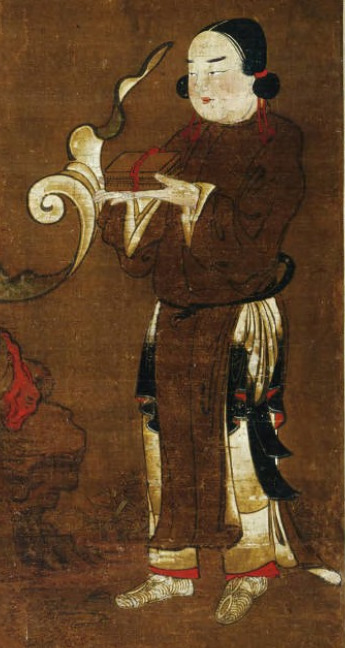
Zennishi Dōji (Princeton University Art Museum; reproduced here for educational purposes only)
Yoshiaki Shimizu has suggested that the connection between Myōren and his Gohō Dōji is meant to mirror that between Bishamonten and his son and primary attendant, Zennishi Dōji (善膩師童子), and highlight that the monk was an incarnation of the deity he worshiped. He also argued that Myōren’s nameless sister (not attested outside Shigisan Engi Emaki) - the character ZUN based Byakuren on - is meant to correspond to Bishamonten’s wife, Kisshōten/Kichijōten (presumably with spousal bond turned into a sibling one). I am not sure if this proposal found broader support, though - I’m personally skeptical.
Kongara Dōji (and Seitaka Dōji): almost Touhou
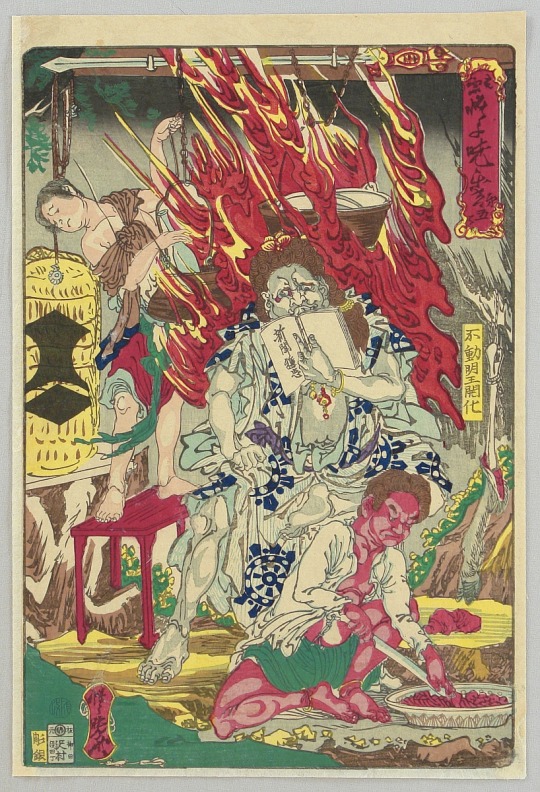
Fudō Myōō, as depicted by Kyōsai (via ukiyo-e.org; reproduced here for educational purposes only)
Kongara Dōji (衿羯羅童子, from Sanskrit Kiṃkara) and Seitaka Dōji (制多迦童子, from Sanskrit Ceṭaka) are arguably uniquely important as far as the divine dōji go - a case can be made that they were the model for the other similar pairs. They are regarded as attendants of Fudō Myōō (Acala), one of the “wisdom kings”, a class of wrathful deities originally regarded as personifications and protectors of a specific mantra or dhāraṇī. In Japanese esoteric Buddhism, they are understood as manifestations of Buddhas responsible for subjugating beings who do not embrace Buddhist teachings.
Acting as Fudō‘s servants is the primary role of Kongara and Seitaka. As a matter of fact, both of their names are derived from Sanskrit terms referring to servitude. This is not reflected in their behavior fully: esoteric Buddhist sources indicate that Kongara is guaranteed to help a devotee who would implore him for help, but Seitaka is likely to disobey such a person. Interestingly, both can be recognized as manifestations of Fudō. This seems to reflect a broader pattern: once a deity ascended to a prominent position in esoteric Buddhism, some of their functions could be reassigned to members of their entourage. ZUN arguably references this in Mai and Satono’s bio, according to which “their abilities (...) are nothing more than an extension of Okina's.”
Despite the aforementioned shared aspect of their nature, Kongara and Seitaka actually have completely different iconographies. Kongara is portrayed with pale skin, wearing a monastic robe (kesa) and with his hands typically joined in a gesture of respect. Seitaka, meanwhile, has red skin, and holds a vajra in his left hand and a staff in the right. His characteristic five tufts of hair are a hairdo historically associated with people who were sentenced to banishment or enslavement. He’s never portrayed wearing a kesa in order to stress that in contrast with his “coworker” he possesses an evil nature. It has been argued the fundamental ambivalence of dōji is behind this difference in temperaments.
While the pair consisting of Kongara and Seitaka represents the most common version of Fudō’s entourage, he could also be portrayed alongside eight (a Chinese tradition) or uncommonly thirty six attendants. The core two are always present no matter how many extra dōji are present, though. Appearing together is essentially their core trait, and probably is part of the reason why they could be identified with other duos of supernatural servants, like En no Gyōja’s attendants Zenki and Gōki (who as you may know are referenced in Touhou in one of Ran’s PCB spell cards, and in a variety of print works).
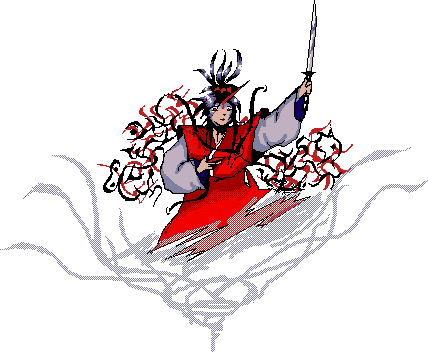
As for the Touhou relevance of Kongara and Seitaka, a character very obviously named after the former appeared all the way back in Highly Responsive to Prayers, but I will admit I am personally skeptical if this can be considered an actual case of adaptation of a religious figure. There are no iconographic similarities between them, and their roles to put it lightly also don't seem particularly similar. Much like the PC-98 use of the term makai (which I will cover next month), it just seems like a random choice.
At least back in the day there was a fanon trend of treating the HRtP Konngara as an oni and a fourth deva of the mountain, but I will admit I never quite got that one. In contrast with Yuugi and Kasen’s counterparts, Kongara's namesake actually doesn’t have anything to do with Shuten Dōji.
The less said about a nonsensical comment on the wiki asserting Kongara’s status as a yaksha (something I have not seen referenced outside of Touhou headcanons, mostly from the reddit/tvtropes side of the fandom) explains why his supposed Touhou counterpart is present in hell, the better.
Uhō Dōji: my life as a teenage Amaterasu protector of gumonji practitioners

Uhō Dōji (Metropolitan Museum of Art)
Uhō Dōji (雨宝童子), “rain treasure child”, will be the last dōji to be discussed here due to being by far the single most unusual member of this category. Following most authors, I described Uhō Dōji as a male figure through the article, but as noted by Anna Andreeva, most depictions are fairly androgynous. Bernard Faure points out sources which seem to refer to Uhō Dōji as female exist too; this is why I went with a gender neutral translation of dōji. In any case, the iconography is fairly consistent, as documented already in the Heian period: youthful face, long hair, wish-fulfilling jewel in one hand, decorated staff in the other, plus somewhat unconventional headwear, namely a five-wheeled stupa (gorintō).
Originally Uhō Dōji was simply a guardian deity of Mount Asama. He is closely associated with Kongōshō-ji, dedicated to the bodhisattva Kokūzō. The latter is locally depicted with Uhō Dōji and Myōjō Tenshi (明星天子), a personification of Venus, as his attendants.Originally the temple was associated with the Shingon school of Buddhism, though today it instead belongs to the Rinzai lineage of Zen.
A legend from the Muromachi period states that Kongōshō-ji was originally established in the sixth century, during the reign of emperor Kinmei by a monk named Kyōtai Shōnin (暁台上人).The latter initially created a place for himself to perform a ritual popularly known as gumonji (properly Gumonji-hō, 求聞持法, “inquiring and retaining [in one’s mind]”).The name Kongōshōji was only given to it later when Kūkai, the founder of the Shingon school of Buddhism (from whose traditions gumonji originates), received two visions - one from a dōji and then another from Amaterasu - that a place suitable to perform gumonji exists on Mount Asama. After arriving there, he stumbled upon the ruins of Kyōtai Shōnin’s temple, so he had it rebuilt and renamed it. Subsequently, Amaterasu appointed Uhō Dōji to the position of the protector of both this location and Buddhist devotees partaking in gumonji in general.
Most of you probably know that gumonji pops up in Touhou as the name of Akyuu’s ability in Perfect Memento in Strict Sense. ZUN describes it simply as perfect memory, but in reality it’s an esoteric religious practice focused on chanting the mantra of Kokūzō 1000000 times over the course of a set period of time (either 100 or 50 days). The goal is to develop perfect memory in order to be able to memorize all Shingon texts, though it is also believed to increase merit and grant prosperity in general. The oldest references to it come from the eighth century, and based on press coverage it is still performed today.
ZUN actually never mentioned gumonji in a context which would stress the term’s Buddhist character. In Forbidden Scrollery Akyuu prays to Iwanagahime rather than to any Buddhist figures. I get the idea behind that, but I will admit I liked the portrayal of her religious activities in Ashiyama’s Gensokyo of Humans much more.

Gumonji aside, the second major point of interest is the connection between Uhō Dōji and Amaterasu. In the legend I’ve summarized above, they are obviously two separate figures, with one taking a subordinate position. This changed later on, though. At some point, most likely between 1419 and 1428, the two deities came to be conflated. As Bernard Faure put it, Uhō Dōji effectively came to be seen as the “Buddhist version of Amaterasu”. To be specific, as Amaterasu at the age of sixteen, presumably to account for the fact that a dōji would by default be a youthful figure.
The treatise Uhō Dōji Keibyaku goes further and asserts that that Uhō Dōji manifests in India as the historical Buddha, Amida and Dainichi; in China as Fuxi, Shennong and Huang Di; and in Japan as Amaterasu, Tsukuyomi and Ninigi. In his astral role, he represents the planet Venus, but he can also manifest as Dakiniten and Benzaiten, in this context understood as respectively lunar and solar. He is also the creator of all of these astral bodies.
The grandiose claims about Uhō Dōji, Amaterasu and other major figures were not exactly uncontroversial. It seems that especially in the eighteenth century the Ise clergy objected to them, presumably because they effectively amounted to their peers at Kongōshō-ji promoting their own deity to make the temple more important as a part of the Ise pilgrimage, which at the time enjoyed considerable popularity.
The association between Amaterasu and Uhō Dōji nonetheless persisted through the Edo period, and despite protests voiced at Ise among laypeople Mount Asama was widely recognized as the third most important destination for participants in the Ise pilgrimage, next to the outer and inner shrines at Ise themselves. It is also quite likely that there was no shortage of people who would imagine Amaterasu looking just like Uhō Dōji.
Ultimately the Uhō Dōji controversy was just one of the many chapters in Amaterasu’s long and complex history, and there was nothing particularly unusual about the claims made. There were quite literally dozens of Buddhist or at least Buddhist-adjacent figures she developed connections to (Bonten, Enma and Mara, to name but a few), and the Ise clergy took active part in this process. Buddhist reinterpretations of Amaterasu flourished especially through the Japanese middle ages.
It was only the era of Meiji reforms that brought the end to this, cementing the Kojiki and Nihon Shoki inspired vision of Amaterasu as the only appropriate one. However, this is beyond the scope of this article. Worry not, though: the very next one I’m working on will cover these matters in detail. Please look forward to it.
Bibliography
Anna Andreeva, “To Overcome the Tyranny of Time”: Stars, Buddhas, and the Arts of Perfect Memory at Mt. Asama
Talia J. Andrei, The Elderly Nun, the Rain-Treasure Child, and the Wish-Fulfilling Jewel: Visualizing Buddhist Networks at the Grand Shrine of Ise
William M. Bodiford, Matara: A Dream King Between Insight and Imagination
Bernard Faure, The Fluid Pantheon (Gods of Medieval Japan vol. 1)
Idem, Protectors and Predators (Gods of Medieval Japan vol. 2)
Idem, Rage and Ravage (Gods of Medieval Japan vol. 3)
Nobumi Iyanaga, Tachikawa-ryū in: Esoteric Buddhism and the Tantras in East Asia
Gaétan Rappo, Heresy and Liminality in Shingon Buddhism: Deciphering a 15th Century Treatise on Right and Wrong
Idem, “Deviant Teachings”. The Tachikawa Lineage as a Moving Concept in Japanese Buddhism
Yoshiaki Shimizu, The "Shigisan-engi" Scrolls, c. 1175
107 notes
·
View notes
Text
Defined
ch: 1 | 2 | 3
synopsis: you and nanami are coworkers and former friends with benefits grappling with the decision to consciously uncouple as a non-couple (aka stop doing each other)
word count: 1,937 words
characters: nanami kento x gn!reader
warnings: angsty kinda, slight sexual mentions this chapter
a/n: i was gonna talk a bunch here about clarifying intentions, labels and titles meaning things, etc. but i thought that was entirely too much... i imagine if you've been anywhere on the fwb/situationship spectrum then you'll just get the gist of it all

"With this, there was no dating. No tender moments in public or meeting family. And no telling coworkers... absolutely not. The closest semblance to a normal partnership was the rare mission assigned together. The ones you both went on afar from Tokyo, apart from the blood and guts, felt a bit like little vacations.
But even if his hands fell onto and held your waist a certain way. Or if his teeth tugged your bottom lip as his to claim. Even with the smiles that bookended your meetings of intimately learning the other's weaknesses. This was not that kind of relationship."
Violet with dying rays of orange and pink melted into the growing spread of navy sky. The moon always seemed to look brighter up north.
So many mundane blessings clicked for you in moments like these. The daily changes in the sky, the gentle crumble and cushion of leaves beneath your sore soles, an intact spine... it all felt so nice. Normal miracles.
Lucky, some would say. You were lucky to experience those blessings.
"Ah, so you're headed to Hiraizumi?"
"Yeah well, nearby. There've been quite a few disappearances near the Satetsu river. I've never been but it seems fairly quiet there otherwise."
"It's pretty... beautiful really. But you'll want to be careful up there. Lots of concentrated energy."
"Of course. I'm looking forward to it."
"Try not to take offense to this, but who'll be going with you? I don't imagine they'd send anyone near there alone unless it was Gojo."
"Well, I'll be with Nanami... we've worked together a couple of times. I think we get along just fine. Should go fine."
"Aren't you lucky..."
"Mmm."
"Seriously though, be careful. For them to assign a grade 1 and semi grade 1 on a single assignment. Sounds like they don't even know how big of a problem it really could be."
"Right... you sure you don't wanna swap places with me, Kusakabe?"
"Don't make me laugh. Try to come back in one piece."
Last week's conversation played in your head while you gradually retreated from the wilderness toward the nearest town. The replay was a welcomed distraction from the internal and external bruises that slowed your pace. It also took away from the freshly-made replay of you nearly being split into pieces by the wickedly sharp appendages of the curse you faced not even an hour before.
"Nanami?"
"...Yes?"
"Thank you... for watching my back there."
Met with silence, not that you were expecting much. An expression of gratitude is a hard conversation point for someone unenthused to relish in their own good deeds. Because he was there, your near-fate was returned to its sender. As planned, the 7:3 Sorcerer's dull blade tore apart the sickened flesh that held the curse together. No rumination of the act on his part out of politeness, sure, but more so out of professionalism.
His position, tried and true, was simple: what kind of sorcerer would he be if he stood by and allowed you to be decapitated by a curse mere feet away from him?
'I need to work on my reaction time...' Who doesn't? You're at the best that you've known yourself at. 'I'm sorry for being a burden...' Fuck no. That doesn't make sense and it sounds pathetic.
Thoughts trailed off as your steps continued. 'Just leave it...' A breeze slapped against your cheeks and your adrenaline continued to fall.
Even now, the silent air between you both was not uncomfortable. Though, it never usually was. Besides, many sorcerers pray for minutes of peace to grow into hours, days, and months. Most find the time after intense combat to be the purest form of peace; from one extreme to its polar opposite in seconds. Colors, light, scents, and temperature all came through so much clearer... more precise in those after moments.
Auras too... and his captivated you. It had for so, so long, but in the duration of your relationship you had rarely seen this particular quick swell, bright glow, and slow decompression. Witnessing it made you grateful.
Strong. By nature and nurture, his strength was hardwired into his body, mind, and soul. It struck a perfect balance with his kindness, something unwavering that you witnessed the moment you ran into him years ago (literally, by immaculate chance) as a salary man.
Kindness and strength, just two of his many traits that defined the humanity you adored. Steady in your meeting, brief union, and eventual break. At every stage, it was never difficult to find Nanami admirable.
“There’s no way they properly considered the risk of this assignment."
What were you two talking about again? Oh—
"Yeah. It's odd that they sent us both."
"It’s… a disheartening situation.”
"..."
You sincerely hoped it wasn't becau—
"...Not because of you..."
"Oh, I... I understand."
Of course you understood, it came with your own strength. But surely he could've handled that curse without yo—
"Thank you for your hard work. You created a wide opening for me to assist. I'm not sure I would've been able to do this without you."
"...Mm. No problem... me either. I certainly couldn't have done this alone."
Your statement was obvious, as you were covered in far more wounds and marks compared to your coworker. You may have landed more blows against the curse, but he certainly managed to move efficiently and avoid the brunt of what you got.
"Are you feeling faint?"
“No… I’m okay. Thanks.”
Maybe faint wasn’t the proper word, but the goosebumps on your skin made it harder to move. Colors, temperature, and that growing navy sky felt colder and colder. Terrible shame that the nearest town was still a 30 minute hike... and that the nearest auxiliary manager was another 20 minutes away.
“Are you sure?”
“…Yeah… I’m just a little chilly…”
In a singular, swift motion, the weight of Nanami’s blazer comfortably swallowed your shoulders. Without hesitation, he had removed the layer for your benefit.
“Your adrenaline is dropping.”
“T-thank you… thanks... but so is yours. Aren’t you cold?”
“My injuries are minor and we don’t have long to go.”
“Okay… well... let me know if you want this back at any point.”
“I’ll be fine.”
If Nanami was anything, he was an excellent coworker. A professional and selfless team player in every sense. The evening grew cooler and despite the donated layer, the chill sank into your exposed skin and down your bones. 15 more minutes, huh?
"Do you think you can make it for the next-"
"Next 15 minutes? Y-yeah, I think so."
"..."
You figured, at least until his question made your knees buckle. His ever watchful eyes took in your attempt to conceal a growing limp. Did this curse really fuck you up that bad?
"Hold on."
Nanami placed a firm hand on your shoulder prompting you to pause and repositioned the harness that holstered his weapon from his back to his shoulder.
"If you're comfortable with this, I'll carry you until we reach town. Please don't feel indebted to me, I don't want your injuries to worsen from oversight."
"I... Nanami..."
God. First, his coat. Now, his back. What more could he give?
He certainly wasn't being chivalrous to prove a point... was he? What point would he even be making?
Well... how long were you going to make him wait...?
"I don't mean to pressure you..."
Hazel eyes, bare of his glasses, were kind and waiting for your answer. A familiar air of disarming patience carved the cold air between you. Were his eyes always this way when looking towards you? Even now?
"N-no. No, it's... I..."
Deep breath... okay.
"Thank you. Thanks... I really appreciate that."
"Okay. Just try not to lean back, I might lose my balance."
He wouldn't, you both knew, but the warning put you at ease. You smiled, nearly drawing out a teasing quip in response. As gently and respectfully as possible, you made your way onto Nanami's back. Your body was pressed flatly against the broad, dense surface of his. With sturdy arms roped around the plush of your thighs that rested on both sides of his waist, he resumed a slower pace.
The bob of his walk complimented the steady rhythm of his heart, both of which reverberated through your own chest making you wish you could sink into him. The newfound warmth soothed the growing aches and you slipped into sleep. No matter how hard you tried, your body could never forget the comfort that his brought you.
"Maybe this isn't a good idea..."
"...Sure."
I guess the illusion of this fantasy had finally caught up to you two. Five months of willingly bending your own limits, testing the line of professionalism and personal boundaries. Neither of you would've ever sought out another sorcerer as a long-term partner. Sort of stupid to think that indulging in each other carnally would be a sustainable form of healing.
With this, there was no dating. No tender moments in public or meeting family. And no telling coworkers... absolutely not. The closest semblance to a normal partnership was the rare mission assigned together. The ones you both went on afar from Tokyo, apart from the blood and guts, felt a bit like little vacations.
But even if his hands fell onto and held your waist a certain way. Or if his teeth tugged your bottom lip as his to claim. Even with the smiles that bookended your meetings of intimately learning the other's weaknesses. This was not that kind of relationship.
"I don't regret where we are. But being like this might do more harm than good longterm."
What an incredibly stupid conversation to have in bed. And what a crazy thing for him to say with his lips still pressed to your neck.
"Kento... I don't think we were planning on doing this forever, right?"
So why do this in the first place? Maybe he doesn't need a friend (is that what you are?) like you anymore. The sex, itself, was never the problem. If it was, the conversation wouldn't have followed your pleads for him to consume every part of you (and him fulfilling every request.) Pillow talk and waxing poetic about alternative lives or separate futures would eventually run dry.
Neither person wanted to escalate beyond where you two comfortably were. Blissfully uncoupled. And as cathartic as it proved, unpacking core memories and histories as a non-couple was... very intimate for the type of relationship you agreed to share.
But sometimes you figured you could do this... it all... forever, at lest with him. Not that forever was particularly long for the average career sorcerer anyway.
Your own trauma was similar to his own formative heartbreaks, both spoken about in bits and pieces scattered across your time together. Compassion and the embracing calm of your bedroom beckoned Nanami's largely regulated vulnerability. Five months of unlocking each other to see and be seen, if only for a few hours.
Maybe what you both really needed was a good therapist?
"Hey... Kento?"
"Yes?"
"Do you still want to work together?"
"Of course... but I think we'll need distance."
"Of course. Yeah... ok. Ok... just don't treat me like a stranger."
"I never will."
Of course. Responsibility was never solely about physical strength, but about balancing the variables: endurance, intuition, experience, maybe even spite at times… but, most importantly, care. And he was always so responsible.
A responsible, capable, and careful man would do what he could to protect you. How cruel would it be for him to suddenly change when your heart had been so close to his, then and now? Of course a responsible man would carry you when you were down and he'd even let you dampen his shoulder with your tears, awake or not. Naturally, he'd let you grieve what should have been let go.
For the sake of work, sanity, and your friendship.
So here you two were. Nearly five more months down the line since your last meeting. And as much as the partnership changed, the players stayed the same. Accepting another rare assignment together, but with the new goal of making it unremarkable. Just work. Open and closed, with no strings attached.
#jjk fic#jujutsu kaisen fic#jjk scenarios#jjk x reader#nanami kento x reader#jjk nanami#nanami kento#nanami headcanons#kento nanami x reader#kento nanami#nanami x reader#nanami kento x you#nanami x you#gn reader#jjk angst
58 notes
·
View notes
